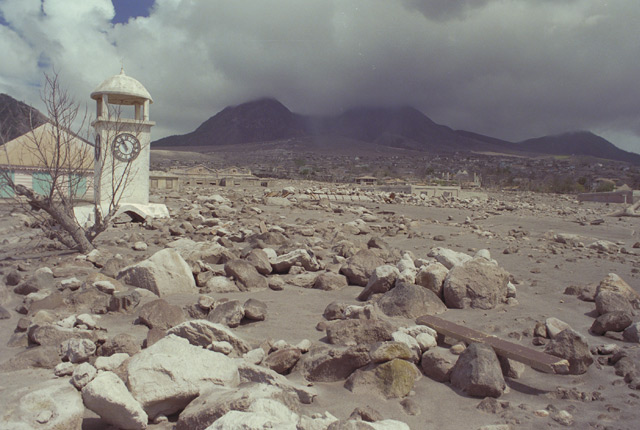This section looks at the relationship between plate tectonics, earthquakes and volcanoes, which helps to explain how volcanoes form.
If you look at a map showing the distribution of earthquakes around the world, it shows that they tend to be concentrated along well-defined belts. Correspondingly, maps of tectonic plate boundaries are primarily produced using earthquake locations. We can also can see from the distribution of volcanoes around the world that most lie on plate boundaries too, in particular a region a called the Pacific Ring of Fire around the edge of the Pacific Plate.
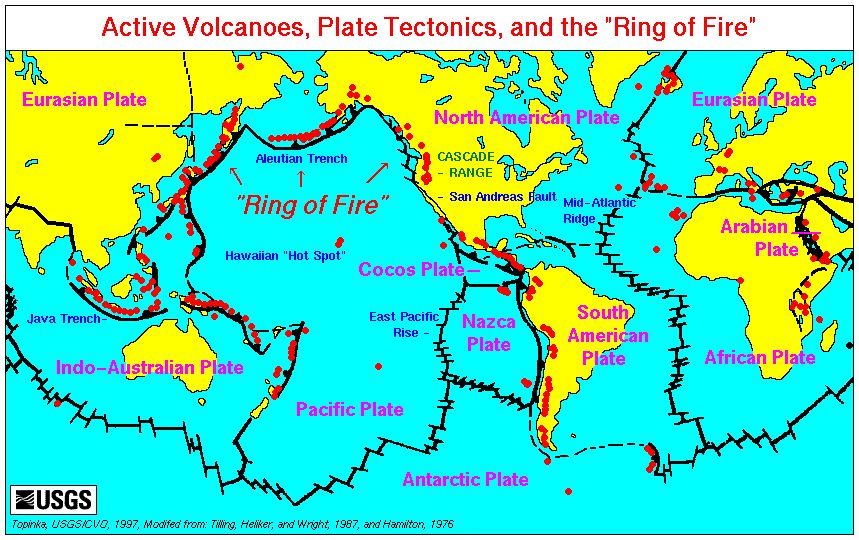
World map showing tectonic plates and the locations of currently active volcanoes. Map courtesy of the US Geological Survey.
The tectonic plates are in contact with each other, but they are also moving relative to one another. The movement of faults at plate boundaries can provide a convenient pathway for magma to reach the surface. It helps to explain this by looking at the three main types of plate boundary:
- constructive boundaries (divergent): where plates are moving away from each other as new crust is created between the two plates
- destructive boundaries (convergent): where plates are moving towards each other and old crust is either dragged down into the mantle at a subduction zone or pushed upwards to form mountain ranges
- transform boundaries (conservative): where are plates are moving past each other and crust is neither created nor destroyed
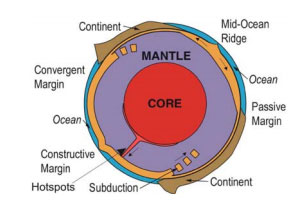
Cross section of the Earth showing the relationship between the structure of the Earth and the movement of the tectonic plates. Ocean crust is coloured light brown and continental crust, dark brown. BGS ©UKRI. All rights reserved.
There are three settings where volcanoes typically form:
- constructive plate boundaries
- destructive plate boundaries
- hot spots
Volcanoes do not typically occur at transform boundaries. One of the reasons for this is that there is little or no magma available at the plate boundary.
Fast Fact
The most common magmas at constructive plate margins are the iron/magnesium-rich magmas that produce basalts. At subduction zones the less iron-rich (intermediate) magmas that produce andesite lavas are most commonly erupted, although silicon-rich magmas sometimes erupt there too.
The balance between iron/magnesium and silicon composition changes the runniness: iron/magnesium-rich basaltic magmas are the most runny (low viscosity) at one end of the scale and silicon-rich are the least runny (highly viscous) at the other end. Basaltic magmas are also usually the hottest and the hotter the magma is the less viscous it is as well. Basaltic magmas also tend to contain few crystals, increasing their runniness. When magmas contain a lot of gas this makes them more runny too, although basaltic magmas usually do not contain much gas. So in summary, iron/magnesium-rich basaltic magmas are free-flowing with low viscosity, while intermediate and silicon-rich magmas are very sticky with high viscosity.
When runny basaltic magma erupts as lava, it pours out of the ground along long surface cracks or through volcanic vents and may be sprayed into the air as spectacular lava fountains. Rivers of lava can flow over the ground or move more slowly as blocky masses bulldozing along. The eruption of intermediate and silicon-rich magma is very different. It erupts from vents, sometimes as lava, but usually the magma becomes solid within the volcanic vent, giving much more explosive eruptions.
Author Chris King, reproduced with the author’s permission from Exploring Geoscience Across The Globe.
Constructive plate boundary volcanoes
At constructive plate boundaries, the tectonic plates are moving away from one another. The Earth’s crust is pulled apart to create a new pathway for rising hot magma to flow on to the surface. Volcanoes can sometimes form in these setting; one example is Iceland.
Iceland lies on the Mid Atlantic Ridge, a constructive plate boundary, where the North American and Eurasian plates are moving away from each other. As the plates pull apart, molten rock (magma) rises up and erupts as lava, creating new ocean crust. The island is covered with more than 100 volcanoes. Some are extinct, but over 30 are still active. The majority of volcanism in Iceland occurs along volcanic rift zones that cut through the centre of the island.
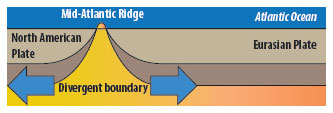
At constructive plate boundaries, also known as divergent boundaries, tectonic plates move away from one another to produce volcanoes. Hot magma rises from the mantle at mid-ocean ridges, pushing the plates apart. BGS © UKRI.
Note: Iceland also sits above a mantle plume, or hot spot, where hot magma wells up from deep in the Earth’s mantle. The interaction of these two types of volcanism, over the last 15 million years or more, has created the island of Iceland.
Destructive plate boundary volcanoes
Destructive, or convergent, plate boundaries are where the tectonic plates are moving towards each other. Volcanoes form here in two settings where either oceanic plate descends below another oceanic plate or an oceanic plate descends below a continental plate. This process is called subduction and creates distinctive types of volcanoes depending on the setting:
- ocean-ocean subduction produces an island-arc volcano
- ocean-continent subduction produces Andean-type volcanoes
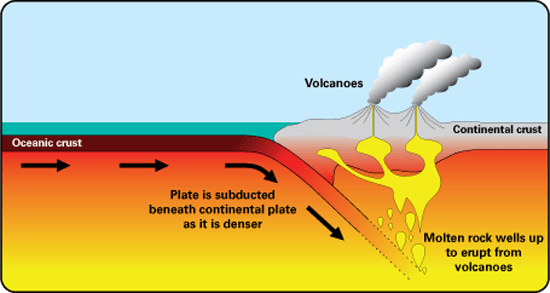
Volcanoes can form at subduction zones where tectonic plates are moving towards each other and one plate descends beneath the other. This illustration shows ocean-continent subduction. BGS © UKRI.
Subduction provides a mechanism for introducing water-bearing sediments into the mantle. As the subducted oceanic plate sinks and heats up, water is gradually released from the sediments and minerals within the plate ‘slab’. Water has the effect of reducing the melting temperature of the mantle by about 60–100°C. It is this process that allows the generation of magma at depth that feeds volcanoes that are formed at the surface.
Note: There is a third setting of destructive boundary: continent-continent. Here, the pushing together of two continental plates results in the mountain forming processes that shaped, for example, the Alps and Himalayas.
Hot-spot volcanism
Volcanoes can also form above a column of superheated magma called a mantle plume. This may happen in areas that are distant from plate boundaries. It is also referred to as hot spot or intraplate volcanism.
Heat from the mantle plume causes melting and thinning of the crust, which leads to volcanic activity at the surface. The Hawai’ian Islands are a chain of volcanoes in the middle of the Pacific Plate, which have formed due to the presence of a hot spot. The Hawai’ian hot spot causes magma to rise and erupt as lava on the ocean floor. Over millions of years, the Pacific Plate has moved over the hot spot, creating a chain of volcanic islands.
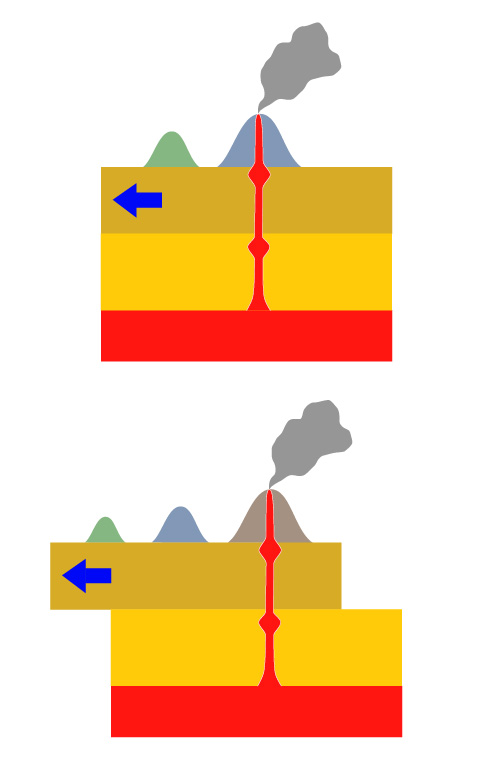
This simple schematic diagram shows the movement of the tectonic plate (light brown) over a mantle plume, or hot spot, to produce a chain of volcanic islands. The superheated magma rises through the mantle (yellow), melts the crust above (brown) and flows on to the surface forming a volcano. Typically, hotspot volcanoes are formed with ‘runny’ lava and have a flatter, less cone-like, profile and are called shield volcanoes. Diagram not to scale. © Public domain.
You may also be interested in

Discovering Geology
Discovering Geology introduces a range of geoscience topics to school-age students and learners of all ages.
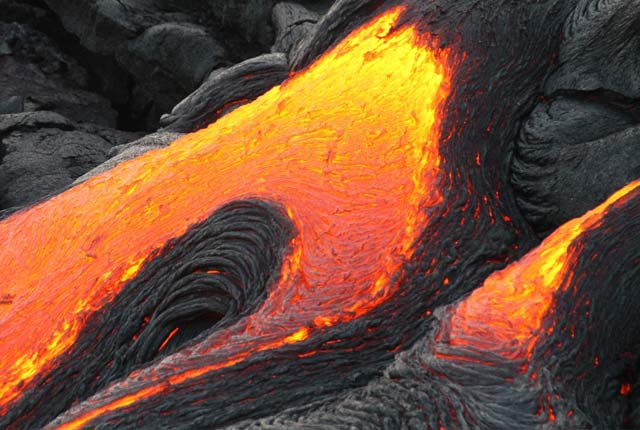
Earth hazards
The Earth beneath our feet is constantly shifting and moving, and violently with catastrophic and immediate results. Find out more about earth hazards.
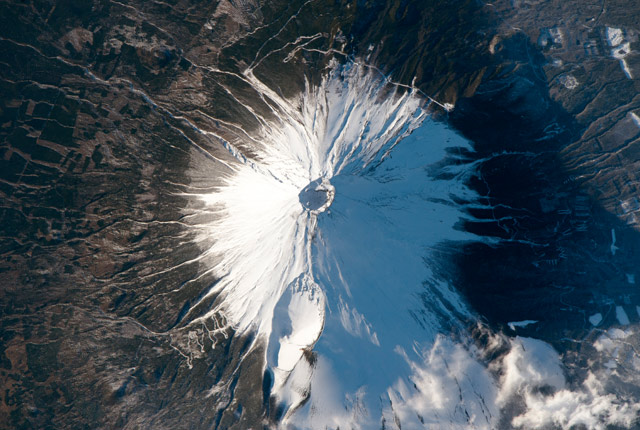
Types of volcano
Different types of volcano are formed according to the properties of the magma that creates them.
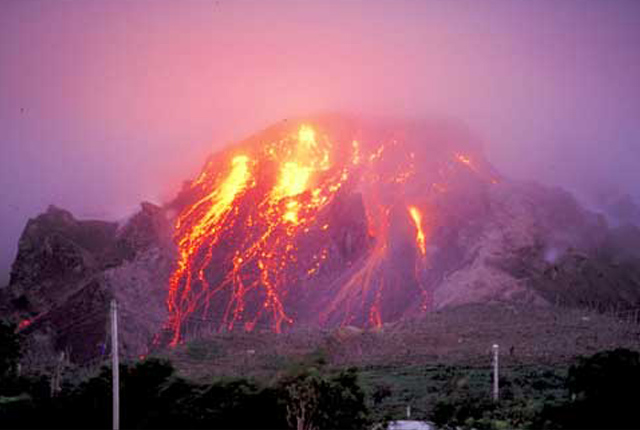
Eruption styles
Volcanic eruptions can be explosive, sending ash, gas and magma high up into the atmosphere, or effusive, producing lava flows and domes.
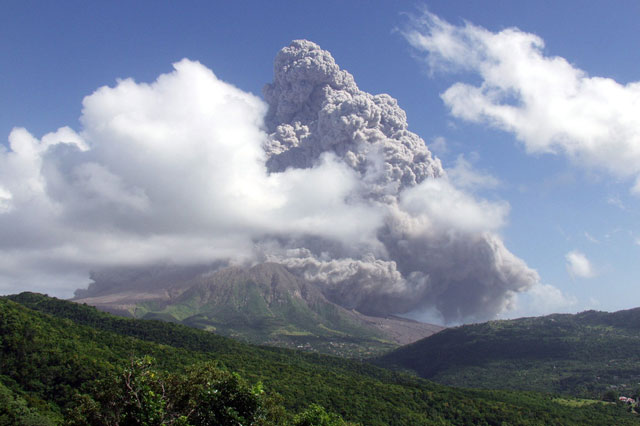
Volcanic hazards
Find out about the different types of volcanic hazards that put human lives, livelihoods or infrastructure at risk of harm.
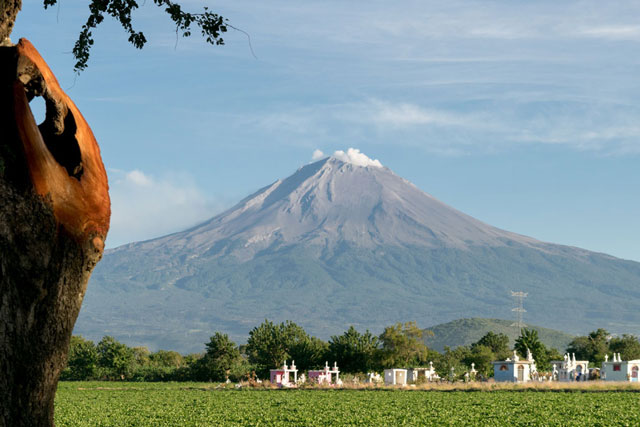
Living with volcanoes
It may seem unwise to choose to live with such a hazardous neighbour as a volcano. There are a number of reasons why people live alongside volcanoes.





